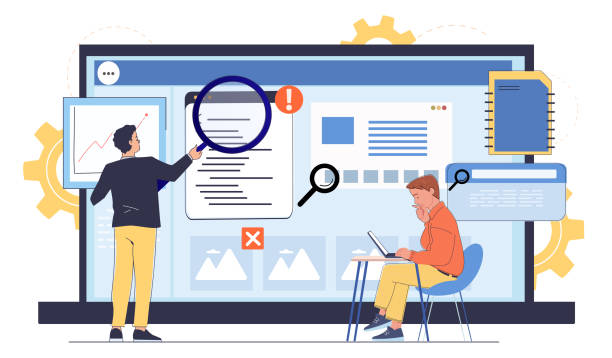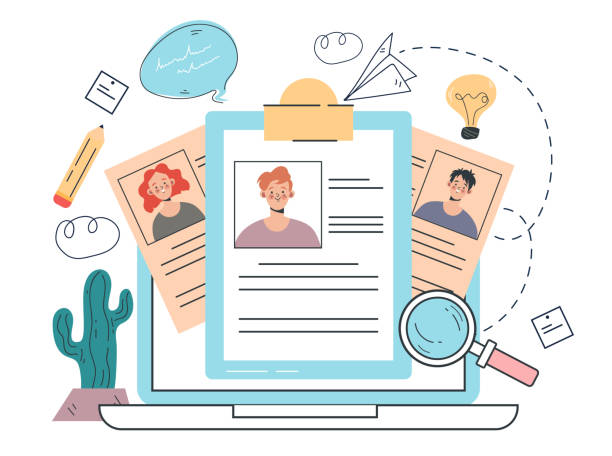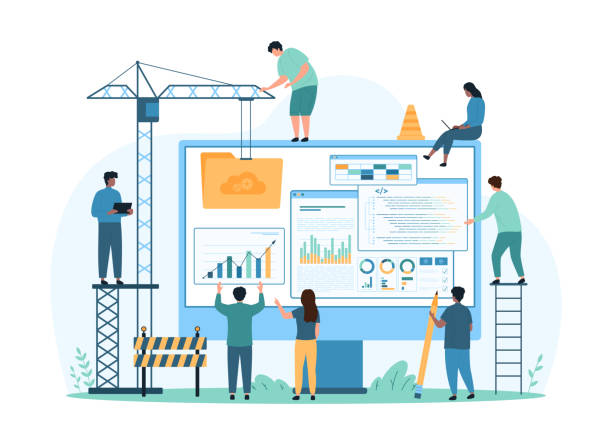Introduction to Modern UI Website Design Principles

In today’s digital world, modern UI website design is no longer just a competitive advantage, but a fundamental necessity for every business and individual seeking an effective and successful online presence.
This type of design is built on a #user-friendly, #visual, and #efficient experience, going beyond mere aesthetic beauty and eye-catching graphics.
Its main goal is to create an #intuitive and enjoyable navigation path for visitors, so that every user, regardless of their technical knowledge level, can quickly and without confusion achieve their goals.
A website with a modern user interface not only looks beautiful and functions well, but also provides a pleasant and hassle-free interaction experience.
This approach encompasses a deep understanding of user behavior, their needs, and how they interact with digital content across various platforms and devices.
Today’s users have very high expectations from a website; they are looking for speed, simplicity, and a seamless experience.
In this educational chapter, we will explain the basic concepts and fundamental principles of web design, focusing on modern user interface.
We will place special emphasis on the importance of features such as high loading speed, which directly impacts user experience and SEO ranking, full responsiveness (flawless compatibility with all types of devices from smartphones to tablets and desktops), and accessibility for all users, regardless of their physical abilities or limitations.
Furthermore, we will delve specialized and deeply into the role of psychology in design; how intelligent selection of colors, fonts, and visual layout can significantly influence user emotions, perceptions, and ultimately decisions, guiding them towards desired actions.
Finally, this section clearly demonstrates how modern UI website design can directly contribute to increasing conversion rates, improving search engine rankings, and building long-term customer loyalty.
This foundational information will be essential for a deeper understanding of the subsequent chapters of the article and provides a comprehensive insight into this dynamic and vital field.
Did you know your website is your customers’ first impression of your company? Boost your business’s credibility with a powerful corporate website from Rasawweb!
✅ Exclusive and eye-catching design tailored to your brand
✅ Improved user experience and increased customer attraction
⚡ Get a free consultation!
Why Modern UI is Crucial for Businesses?
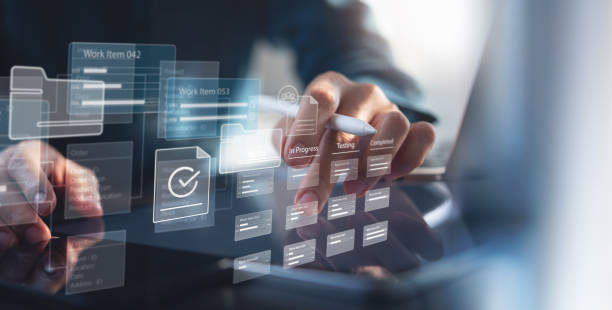
The importance of User Interface (UI) and User Experience (UX) in the online success of a business is undeniable.
An outdated and inefficient UI can quickly drive visitors away from your website, even if your content is highly valuable.
In contrast, modern UI website design not only gives your website an attractive and professional appearance but also directly impacts your engagement rates, conversion rates, and ultimately, your business’s profitability.
Today’s users, with access to countless options, are not patient and seek the best and smoothest possible experience.
Poor design can mean losing potential customers and damaging brand reputation.
This chapter, with an analytical approach, explores deeper reasons why investing in modern UI website design is a strategic decision for any business.
From a news perspective, recent reports indicate that companies investing in UI/UX improvements have seen a significant increase in return on investment.
These designs lead to reduced bounce rates, increased user time on site, improved content engagement, and enhanced customer satisfaction.
When users can easily find what they’re looking for and have an enjoyable user experience, they are more likely to return and become loyal customers.
Furthermore, modern UI helps your website achieve a better ranking in search engines, as Google’s algorithms heavily prioritize user experience factors.
Consequently, this is a long-term investment that significantly contributes to brand strengthening and business sustainability in today’s competitive market.
Key Principles of Modern UI Design
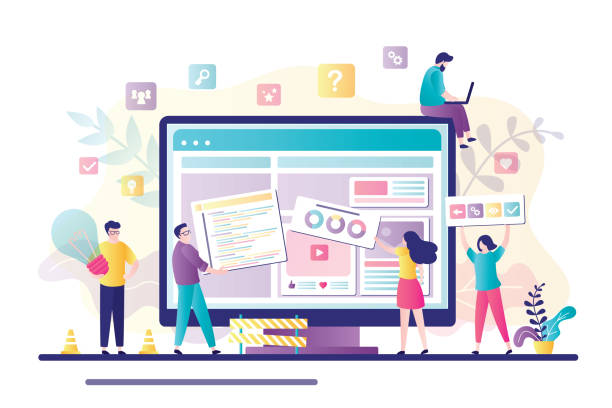
Success in modern UI website design requires understanding and applying a set of fundamental principles that go beyond mere aesthetics.
These principles ensure that the website not only looks beautiful but is also efficient, accessible, and pleasant for users.
The first and most important principle is user-centricity; meaning every design decision must be made considering the needs, behaviors, and goals of the end-user.
This involves conducting thorough user research, creating personas and user scenarios for a deeper understanding of the audience.
The next principle is simplicity and minimalism, which helps eliminate unnecessary elements and visual clutter, allowing the user to focus on the main content.
Responsiveness is also a vital principle in modern UI website design; the website must display seamlessly and perform well across all types of devices and screen sizes, from smartphones to tablets and large monitors.
Another important principle is Accessibility, meaning the website should be usable for all users, including those with disabilities.
This includes using appropriate color contrast, alt text for images, and keyboard navigation.
This descriptive section elaborates on each of these principles and provides practical guidelines for their implementation.
Finally, Consistency in visual and interactive design throughout the website is essential for creating a unified and predictable user experience.
Understanding these principles is fundamental to creating websites that are not only appealing but genuinely serve their users.
| Principle | Description | Importance for User |
|---|---|---|
| User-Centricity | Design based on the needs and goals of the end-user. | Personalized and effective user experience. |
| Simplicity and Minimalism | Eliminating superfluous elements and focusing on core content. | Reduced confusion, increased focus. |
| Responsiveness | Compatibility with various devices and screen sizes. | Accessibility anytime, anywhere. |
| Accessibility | Usable by all, including people with disabilities. | Inclusion for all users. |
| Consistency | Uniformity in visual and interactive design. | Creating a predictable and reliable user experience. |
New Tools and Technologies in UI Design

To create a modern and efficient user interface, designers rely on a suite of advanced tools and technologies.
These tools make the design process simpler, more efficient, and more feasible, from initial ideation to final implementation.
Graphic design software like Adobe XD, Figma, and Sketch allow designers to create wireframes, prototypes, and final user interfaces with high precision and speed.
These tools also enable real-time collaboration, which is crucial for large teams and complex projects.
Furthermore, web development frameworks such as React, Vue.js, and Angular play a significant role in implementing dynamic and interactive user interfaces.
This section, as a comprehensive guide, introduces key tools and emerging technologies in the field of modern UI website design.
We will examine CSS frameworks like Bootstrap and Tailwind CSS, which facilitate the responsive development process.
Also, project management tools like Trello or Asana and version control systems like Git are essential for effective collaboration between design and development teams.
The use of Design Systems has also become increasingly important; these systems provide a collection of reusable components, branding guidelines, and best design practices that help maintain consistency and efficiency in large projects.
Understanding these technologies and tools is essential for any designer and developer seeking to create outstanding user experiences, helping them stay up-to-date in the fast-paced world of technology.
This specialized information illuminates the path for selecting the right tools.
Are visitors leaving your e-commerce site before purchasing? Worry no more! With Rasawweb’s professional e-commerce website design services, solve the problem of converting visitors into customers forever!
✅ Significantly increased conversion rates and sales
✅ Unparalleled and engaging user experience
⚡ Contact us now for a free consultation!
Step-by-Step Modern UI Design Process
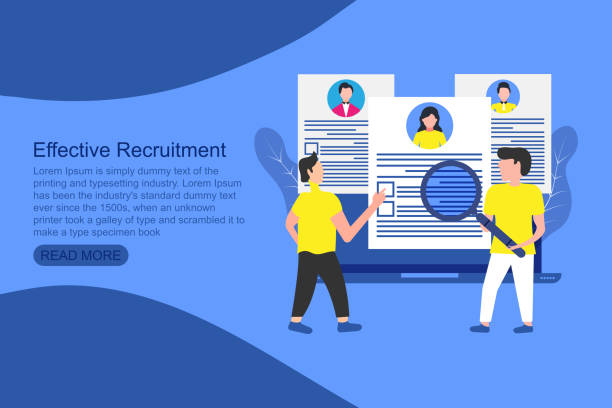
The process of modern UI website design is a systematic and iterative approach consisting of various phases.
This process ensures that the final product is not only visually appealing but also meets user needs and achieves business objectives.
The first step is research and discovery, which involves a deep understanding of the target audience, competitor analysis, and identifying user needs and problems.
This phase includes user interviews, surveys, and reviewing existing data to solidify the design foundations.
Following this, the information architecture and wireframing stage begins, where the overall website structure, content hierarchy, and page element layout are defined.
In this section, with a descriptive and guidance approach, we will outline the key steps in the modern UI website design process.
After wireframing, it’s time for prototyping, where interactive versions of the designs are created to allow for testing and feedback.
These prototypes can range from Low-fidelity (simple) to High-fidelity (very detailed and close to the final product).
The next crucial step is user testing; in this stage, prototypes or early versions of the website are given to real users to identify design strengths and weaknesses.
Feedback received at this stage helps iterate and improve the design.
This cycle of research, design, prototype, and testing continues iteratively until the best possible outcome is achieved.
This structured process helps teams ensure that every aspect of the design has been carefully reviewed and optimized, ultimately leading to the delivery of an unparalleled user experience.
Importance of Visual Elements in Modern UI
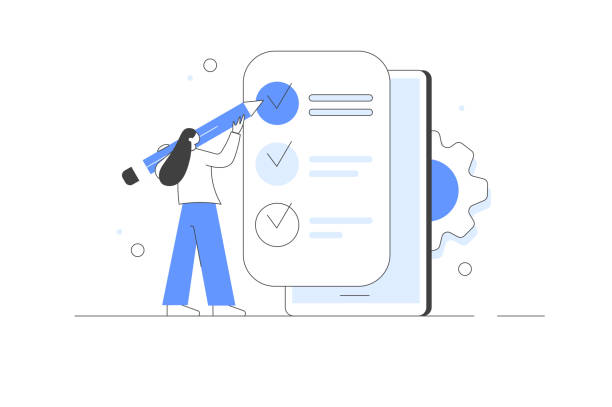
Visual elements play a pivotal role in modern UI website design.
These elements not only determine the website’s aesthetic appeal but also directly influence how users perceive and interact with content.
Intelligent selection of colors can evoke specific emotions and reinforce visual hierarchy.
For example, bright and vibrant colors can convey a sense of excitement and energy, while calmer colors evoke trust and tranquility.
Typography (font selection and text display) is also crucial; readability, visual hierarchy, and brand identity are all influenced by typography.
This chapter, with an analytical perspective, delves into the details of key visual elements in modern UI website design.
Images and icons must be high-quality, relevant to the content, and visually appealing.
Using low-quality stock images can diminish a website’s credibility.
Icons should be simple, recognizable, and consistent with the overall design style to aid quick navigation.
Whitespace, often overlooked, is crucial for giving elements breathing room and enhancing readability.
Proper use of whitespace makes the layout appear cleaner and more organized, preventing clutter.
Finally, visual design trends such as Material Design and Skeuomorphism are also examined to provide a more comprehensive view of aesthetic choices in design.
These visual elements together create a beautiful and efficient user experience.
Interactive Elements and Animations in Modern User Experience
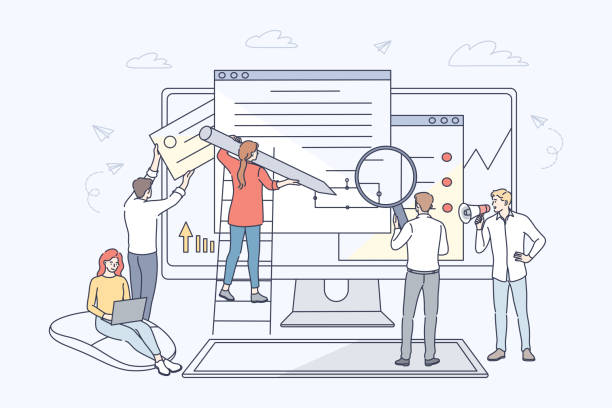
In modern UI website design, interactive elements and animations play a crucial role in enriching the user experience and increasing visual appeal.
These elements go beyond mere aesthetics; they provide feedback to users, aid navigation, and can even present complex information in an engaging and understandable manner.
Micro-interactions, such as a button changing color on hover or a small loading animation, are subtle details that create a pleasant feeling and assure the user that the system is responding to their input.
These small details can make a big difference in the user’s overall feeling and make the experience smoother.
This section, in a descriptive and specialized manner, delves into various interactive elements and the intelligent applications of animations in modern UI website design.
Animations can be used for transitions between pages, showing state changes (e.g., a menu opening), or drawing user attention to specific elements.
Correct use of animations helps improve visual appeal and streamlining the user flow, but overdoing them can lead to distraction or reduced website loading speed.
Various types of buttons, interactive forms, sliders, and carousels are also commonly used interactive elements that must be carefully designed to achieve maximum efficiency.
The ultimate goal of these elements is to create a thought-provoking and engaging content experience that encourages the user to continue exploring the website and builds an emotional connection with the brand.
These tools can elevate the user experience from merely functional to an enjoyable and memorable one.
| Interactive Element | Primary Application | Animation/Feedback Example |
|---|---|---|
| Buttons | Call to action, navigation. | Color or shadow change on Hover, click effect. |
| Forms | Information gathering, user input. | Real-time input validation, field animation. |
| Navigation Menus | Aid site movement. | Opening and closing animation, Hover effects. |
| Loaders | Display loading process. | Spinners, progress animations. |
| Slider/Carousel | Display multiple content in limited space. | Smooth image transitions, navigation buttons. |
Performance and Optimization in Modern Web Design

Modern UI website design is not limited to aesthetic beauty and visual appeal; performance and optimization are also among its core pillars.
A beautifully designed website with slow loading speed creates a frustrating user experience and can lead to the loss of visitors and potential customers.
Page Load Speed is one of the most critical factors in user experience and also in search engine ranking (SEO).
Users expect websites to load quickly, and any small delay can lead to a high bounce rate.
This chapter, with an analytical approach, discusses the importance of performance and optimization methods in modern UI website design.
Image optimization (compression without losing quality), using a CDN (Content Delivery Network) for faster content delivery, and reducing unnecessary CSS and JavaScript codes are among the most important techniques.
Caching and Lazy Loading of images and videos also significantly help improve speed.
Furthermore, mobile optimization, which includes responsive and Mobile-First design, plays a vital role in overall performance, as a significant portion of web traffic comes from mobile devices.
This comprehensive guide introduces tools like Google PageSpeed Insights and GTmetrix for performance evaluation and bottleneck identification.
Ultimately, focusing on performance ensures that the website not only looks good but also has high efficiency and provides an optimal user experience in all conditions.
Is your e-commerce site ready to attract maximum customers and increase sales? Rasawweb transforms your online business with modern and efficient e-commerce website designs.
✅ Increased speed and improved SEO
✅ Excellent user experience on mobile and desktop⚡ Get a free e-commerce website design consultation from Rasawweb!
The Future of UI Design and Emerging Trends
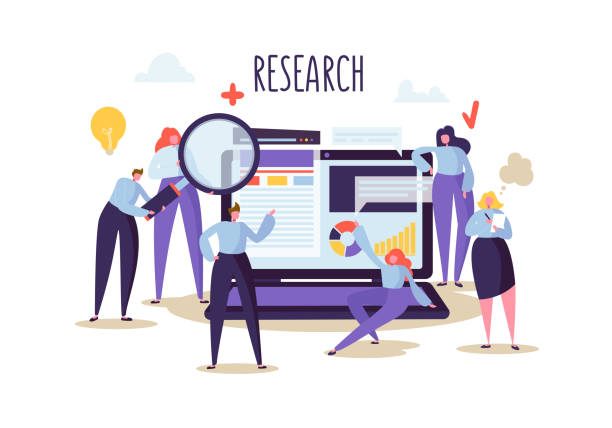
The world of modern UI website design is constantly evolving and innovating.
With technological advancements, new trends emerge that elevate user experience to unprecedented levels.
One of the most prominent future trends is the use of Artificial Intelligence (AI) and machine learning in personalizing the user experience.
AI can analyze user behavior and dynamically adjust the user interface to each individual’s needs and preferences.
This personalization can include suggesting relevant content, custom layouts, and even adjusting colors and fonts.
Voice User Interfaces (Voice UI) and Augmented Reality/Virtual Reality User Interfaces (AR/VR UI) are also emerging trends that allow users to interact with websites in entirely new and immersive ways.
This chapter, with a thought-provoking and news-oriented approach, explores the future horizons in modern UI website design.
Designing No User Interfaces (No UI), where interactions are highly natural and intuitive, reducing the need for traditional interfaces, is another future concept.
This includes the use of gestures, facial recognition, and other natural inputs.
Additionally, an increasing focus on sustainability and green design in web development to reduce energy consumption and environmental impact of websites is a significant emerging trend.
Future designers must prepare themselves for these changes and acquire new skills in data analysis, behavioral psychology, and advanced technologies.
This future outlook indicates that modern UI, beyond being a visual aspect, will become the heart of users’ digital experience and will shift the boundaries of human-computer interaction.
Challenges and Solutions in Modern UI Design

Like any other field, modern UI website design faces its own specific challenges.
One of the biggest challenges is maintaining a balance between aesthetics and functionality.
Sometimes, designers focus too much on visual aspects and neglect principles of functionality and accessibility, leading to a suboptimal user experience.
Another challenge is the constant changes in technology and user expectations.
Design trends change rapidly, and what is considered modern today may be deemed outdated tomorrow.
This necessitates continuous learning and updating of knowledge and skills by designers.
Also, compatibility with different browsers and various devices (Cross-Browser Compatibility) remains a significant concern.
This chapter, with an analytical and guidance approach, examines common challenges in modern UI website design and effective solutions to overcome them.
Project complexity, especially for large websites with intricate functionalities, requires meticulous management and effective collaboration among various teams (design, development, marketing).
Solutions such as utilizing Design Systems that ensure integration and consistency, conducting continuous user testing to identify and resolve issues in early stages, and continuous training for teams to keep pace with the latest trends and technologies, can be effective in addressing these challenges.
Also, emphasizing minimalism and simplicity in design can prevent unnecessary complexities.
With a smart and planned approach, these challenges can be overcome to create websites that are both beautiful and optimally meet user needs.
Frequently Asked Questions
| Question | Answer |
|---|---|
| What is modern UI website design? | An approach that focuses on simplicity, visual appeal, user-friendliness, and the use of the latest design trends. |
| What are the key principles of modern UI? | Simplicity, clarity, accessibility, responsiveness, and focus on user experience. |
| Why is the use of whitespace important in modern design? | Whitespace helps with readability, user focus on content, and creates a sense of order and aesthetics. |
| What is the role of typography in modern UI? | Choosing the right font greatly contributes to brand identity, text readability, and creating visual hierarchy. |
| How can colors be used effectively in modern design? | Strategic use of an appropriate color palette to guide the user’s eye, create brand mood, and improve accessibility. |
| What role do visual elements like icons and images play? | These elements contribute to visual appeal, rapid message transfer, and improved user understanding of content. |
| What is the importance of responsiveness in modern design? | It is essential for the site to have a desirable appearance and correct functionality across all devices like mobile, tablet, and desktop. |
| How does modern UI contribute to User Experience (UX)? | By creating an attractive and user-friendly visual environment, easier navigation, and more enjoyable interaction, the overall user experience is improved. |
| What are some common trends in modern UI? | Dark Mode, Neomorphism, Glassmorphism, subtle animations, and micro-interactions. |
| What steps are necessary to achieve a modern UI? | User research, wireframing and prototyping, user testing, and using up-to-date tools and frameworks. |
And other services of Rasawweb Advertising Agency in the field of advertising
Smart Content Strategy: A new service to enhance campaign management through custom programming.
Smart SEO: A dedicated service for growth in campaign management based on real data.
Smart UI/UX: A professional solution for digital branding with a focus on optimizing key pages.
Smart Marketplace: A combination of creativity and technology for user interaction through key page optimization.
Smart Digital Branding: A blend of creativity and technology to improve SEO ranking through attractive UI design.
And over hundreds of other services in the field of internet advertising, advertising consultation, and organizational solutions
Internet Advertising | Advertising Strategy | Advertorials
Sources
- Modern Website Design and its Principles
- Principles of User Experience (UX) Design in Web
- The Future of User Interface (UI) and New Trends
- Superior User Experience and the Future of Web
With Rasawweb Afarin, transform your business in the digital world! We pave your path to online success by providing comprehensive digital marketing services including corporate website design, SEO, and social media management. Shine with us and reach the peaks of your business.
📍 Tehran, Mirdamad Street, next to Bank Markazi, Kazeroun Jonoubi Alley, Ramin Alley, No. 6

